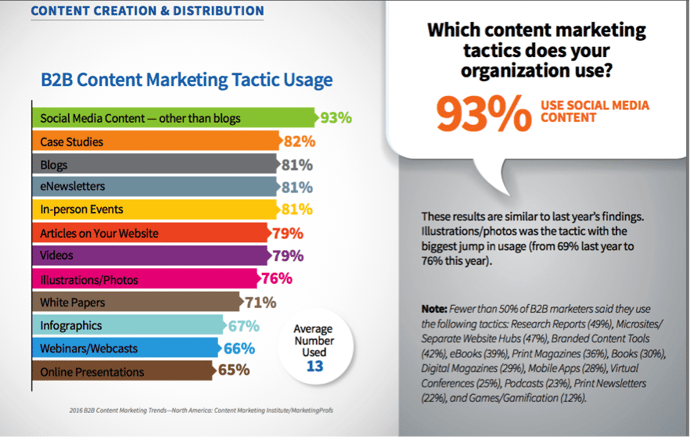For many business in highly regulated environments (such as pharma, medtech, health care and financial sectors), social media may seem like a tool that is either irrelevant or too difficult to manage within stringent and often-changing regulatory parameters. Yet, the truth is, social media is just as applicable to these sectors as other B2B markets, and can be equally as effective. Being compliant and being quiet are not irreversibly fused.

Social media for B2B?
Yes, some of you out there may still think that social media is only for fun and games. Nothing serious is ever accomplished there, and even when serious topics (like politics) are discussed, it’s nothing but avarice and opinions. Right? Well, wrong.
Social media is a very effective tool for many B2B companies not only for promoting their content (more on this here) but also for keeping tabs on the pulse of their markets — what's known as social listening. In fact, according to a 2016 report from Content Marketing Institute, 93% of B2B marketing organizations use social media. However, according to the same report, only 35% have documented their social media strategy. This could be a major downfall to success (read on for tips below).
(Graphic from Content Marketing Institute Report)
If you’re not monitoring or participating in the conversation, how can you possibly know what your customers, colleagues, partners and prospects are thinking?
This brings me to two important aspects of social media in the B2B world, including regulated industries like healthcare, diagnostics and medical devices. You must focus on both monitoring and engagement.
That translates into LISTENING and SHARING.
Social media monitoring and engagement
Monitoring (listening) in social media means following your customers, partners or networks on Facebook, Twitter, LinkedIn, YouTube and Google+ and other channels, and regularly checking your streams so you are aware of what others in your space are saying. You can use tools such as Hootsuite, HubSpot or Sprout Social to monitor important subject areas and “follow" people you want to stay connected to, setting up alerts for particular areas of interest or “hot topics.”
Engagement (sharing) in social media means contributing to the conversation with new content, thoughts, ideas, reports, images, infographics and other content that your followers and audiences might find useful. It's not (just) about self-promotion, but also about sharing ideas and contributing to a conversation. Your contributions can be entirely original (such as predictions, posts or reports that you or your company have produced), insights or perspectives on work from others (like adding your comments on news about a new law or protocol) or sharing things you found useful (such as a “How to” article or seminar presentation from the last conference you attended). Apply a simple rule: if your content passes medical, legal and regulatory review processes, it's a candidate to build an engagement strategy.
How to keep your content compliant
In any business, but especially in the regulated industries, managing your brand’s reputation and keeping your company safe from infractions (perceived or real) requires a few extra steps to ensure success. You’ll want to create a plan that is approved at the highest levels of your organization and followed by everyone in the company who posts on behalf of your brand. Here are some tips for creating a well-organized social media plan:
1. Create a set of guidelines.
The most important first step is to create a document outlining the issues that can and can’t be discussed. If you have proprietary new research or R&D that is classified, all of your team members should be made aware (and firmly reminded) that all such topics are off limits. Be very specific about the words they can and can’t use. However, they may find that the knowledge they have in these areas makes a useful addition to online conversations or in discussions on professional forums. In that case, they should be clearly instructed about what issues are “fair game” for discussion, and where the boundaries are that cross into proprietary, protected or regulated information. Your team should be well briefed in the difference between presenting new facts and helpful information, and any speculation that could appear as an endorsement or recommendation around regulated topics. (Get a sample social media guidelines template here).
2. Develop written talking points.
A simple document or guide that outlines to your team all the most important “themes” or areas of expertise for your company, such as focus areas or new business areas, will give your team the ammunition they need to focus where you want them to focus. You might think everyone knows what to concentrate on, but if you haven’t put pen to paper (or more likely, hands to keyboard), you can’t be sure they are all on the same page.
3. Prepare a content calendar.
Turn your talking points into a social media calendar with posts planned for a week or more at a time. Focus on topics around which your company has expertise and wishes to become known in the market. Include a combination of curated and created content (posts linking back to blog articles or research papers, as well as content you share from other experts, industry conferences or partners). Remember: you want your topics to be about issues, not products. Consider what challenges your target audience is facing and talk to them about things they care about. Mention the problems your products solve, not the brands. The exception would be answering or responding to specific questions that others may post online about your products. (Need inspiration? Download a sample social media planning template here.)
4. Institute an approval process.
In some industries, fly-by-the-seat-of-your-pants witty responses might win points. But in highly regulated industries, off-the-cuff remarks could end up costing you dearly. Make sure that all your content and comments are approved in advance. Create a written approval process (approval template documents help) that everyone on the team understands. Include an approval “check off” at the top of your editorial calendar or blog post templates to indicate who needs to approve it and by when.
5. “Chunk” your content.
One way to ease (and speed) the approval process for new posts is to pull your social media comments and ideas from pre-approved content. Create larger pieces regularly (such as articles, case studies or white papers) with ideas that can be approved all at once. Then, pull bits and pieces of this into social media-worthy posts that let you spread your content out over several weeks.
6. Rework and reuse existing content.
Similarly, you can reuse existing content by turning it into new formats without requiring a lengthy regulatory approval process. Turn a research paper presented at a conference into a series of infographics, Slideshares, or video for YouTube (have the writer or a company thought-leader read it on camera and mix in still graphics or slides with charts). Create Tweetable callout images from the key data that link to a page where people can read the entire report. Turn the presentation into an “interview” with the expert. Think about additional ways to present content that might appeal to your audience.
7. Get help.
If you need additional resources to ensure your content is appealing and also compliant, you might consider looking to outside experts. Look to outsourced resources who have experience writing for regulated industries and know the ins and outs of posting content to social media.
Have any other concerns?
Do you have other concerns about social media we didn’t address here? Ask us in the comments and we’ll be glad to help.

